The sensual cell of Descartes
Western culture has developed a well-defined hierarchy of the senses in which smell, touch, taste, and hearing occupy a distant, marginal place. In contrast to sight, which is associated with thinking, hearing has never been regarded as a fully-qualified tool of cognition and philosophy, as it is in Jewish culture, for instance. The borders were demarcated on one hand by the cultural paradigm and the frame of mind it engendered, and on the other by our physiological capabilities. Our perception of reality depends, after all, on the parameters of human perception: the range of audible frequencies, the sharpness of our sight, the acuteness of our smell. Those who display special cognitive predispositions have always been treated as shamans, saints, or madmen.
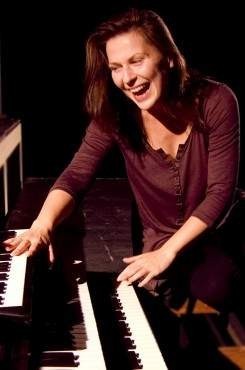 Jagoda Szmytka, photo: David GonterThe Western order of the senses is not justified by any objective state of affairs. The senses, after all, can be honed; technology itself has had a noticeable reorganizing effect on our perception, while art continues to put our senses to the test. The arbitrariness of the boundaries and our irresistible compulsion to differentiate is demonstrated by the evolution of particular artistic disciplines: in the history of aesthetics, the distinctions between painting, music, and literature have shifted time and time again.
Jagoda Szmytka, photo: David GonterThe Western order of the senses is not justified by any objective state of affairs. The senses, after all, can be honed; technology itself has had a noticeable reorganizing effect on our perception, while art continues to put our senses to the test. The arbitrariness of the boundaries and our irresistible compulsion to differentiate is demonstrated by the evolution of particular artistic disciplines: in the history of aesthetics, the distinctions between painting, music, and literature have shifted time and time again.
One contemporary artist that challenges us with this problem is Jagoda Szmytka. Her intellectual, aesthetic, and sensual experiences are myriad. In her work, she employs a variety of media and material, building layered and rhizomatic semantic-aesthetic fields. She does not discern between sound and image, philosophical idea and touch. This places her among the likes of Skriabin, Schönberg, Messiaen, Stockhausen, to name but a handful of composers who displayed synesthetic predispositions. Synesthesia was unfathomable to Descartes, who established the primacy of the eye and word (writing) in Western culture. Colour, sound, touch, movement, and thought: all of these were thought to be mutually contradictory.
“Sound is (for) more than the ear — it is also for the body, for the eye, and for thinking.”
Jagoda Szmytka: “Images in motion are a part of music as long as they have the structure of sound and are perceived as sounds. Visual material is a part of the composition as long as no one closes their eyes and misses part of the music.”
Synesthesia isn’t an artistic strategy, a choice of media, or an external stimulus. Jagoda Szmytka discovered her synesthesia early on in life. Even choosing a high school (music or art?) was a challenge for her. She ultimately chose a music school, and specialised in the flute. After graduation, the problem reappeared: should she major in painting or the flute? She opted for art history and music theory, later taking up philosophy, and finally composition. She even entertained thoughts of studying film directing along the way. All of this is reflected in her musical pieces.
Jagoda Szmytka
Jagoda Szmytka (1982) studied composition in Wrocław, Graz, and Frankfurt under the tutelage of Krystian Kiełb, Cezary Duchnowski, Beata Furrera, Pierluigi Billone, and Gerhard Müller-Hornbach. She began her post-graduate studies under Wolfgang Rihm in 2010. Szmytka is the recipient of numerous scholarships from Polish, German, and Austrian foundations. She has taken part in master workshops conducted by Helmut Lachenmann, Mark Andre, Georg Friedrich Haas, Vinko Globokar, Mauricio Sotelo, and Tristan Murail. Her music has been performed at the Warsaw Autumn Festival, the KODY Festival (Lublin), Musica Polonica Nova and Musica Electronica Nova (Wrocław), Acanthes (Metz), ENSEMS (Valencia), Donaueschinger Musiktage (Off-Programm), Tokyo Experimental Festival, Audio Art (Kraków), Mediascapes (Graz), and the Interfering Rostrum for Electro-Acoustic Music (Lisbon). She has worked in such institutions as Zentrum für Kunst und Medientechnologie (ZKM) Karlsruhe, Experimentalstudio des SWR Freiburg, Frankfurt-LAB, and Kunsthaus Graz. In the spring of 2011, Szmytka received the prestigious “Staubach Honoraria” award, thanks to which her new composition for Ensemble BESIDES will premiere at the Summer Courses in Darmstadt in 2012.
Jagoda Szmytka’s creative development may be described as a gradual but decisive blurring of the boundaries of perception and the art it defines. Her first pieces, such as traffic (2005) for reciter and tape, io (2006) for flute and computer, nja (2007) for tenor saxophone and computer, jasinn (2007) for mixed choir, four instruments, electronic sounds and computer, are intuitive attempts to face sound (instruments/voice plus electronics), musical narrative, and form. Her sensitivity to timbre is intriguing, as is the interesting rhythm with which she develops the drama and her bold instrumental technique. But these are merely attempts at fulfilling certain general and widely accepted notions about what music is and who the composer is.
The questions start with her multimedia composition ¿i? study of who where when (2008) for harpsichord/piano, metronome, tape recorder, electric sounds, video, and lights. In the commentary Szmytka writes: “I began to wonder who ‘someone who plays’ is, what ‘this instrument’ is, what this piece and its performance are, and what the relationship between the performer and ‘this particular instrument’ are. One of my first thoughts was of ‘ON-OFF’, ‘ON-OFF’ — the sound of switching a butting on and off, turning a sound on and off, the movement of fingers, hands, arms, and the mechanical work that takes place inside the instrument. After a moment of reflection, the idea turned out to be rather complex. Does sound start with the striking of the string? Even a delicate touch can cause (micro)resonance. Will it be audible? Does audibility set the boundaries of sound? How do we determine the initial boundary of sound? The beginning and the end? What happens if you can see the piece before actually hearing it? Or what if the performance starts before rehearsal ends?”
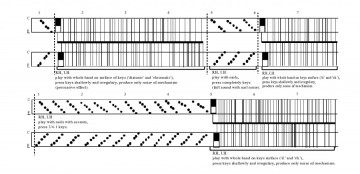 J. Szmytka, study of who when where (2008), score fragment
J. Szmytka, study of who when where (2008), score fragment
Two pieces marked a turning point: jonction (2006) for a ensemble, and per ._o (2007) for three performers. The first was a typical concert piece: dynamically developing, organic sound tissue. The second: a ritual of gesture and a study of the material; unity of the auditory, visual, and tactile spheres.
per ._o is Jagoda Szmytka’s first major step towards her own definition of music that is more than just sonorous matter defined by narrative of sound, but an experience and a philosophy. It touches upon such issues as identity, language, body, gesture, shape, light, and writing. Each of these elements enter into subtle and sublime interaction in Szmytka’s work, dissolving aesthetic and cognitive categories.
Gesture and energy
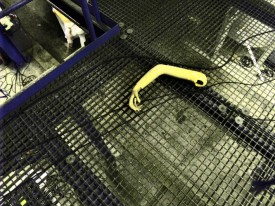 Just in time, performance in EVO,
Just in time, performance in EVO,
Frankfurt am Main (2010)per ._o is a ritual for two flautists and a pianist. It opens with operations performed on rocks, after which comes a series of actions involving the mouthpieces of the flutes and the strings of the piano (only the highest and lowest registers). There is something “Japanese” about the austerity of the piece, but it’s not about some fascination with Asian culture. Jagoda Szmytka is a modernist in the Western sense of the word. If non-European musical culture makes any appearances in her work, it is because of her unique approach to sound as shape (calligraphy = gesture writing).
Jagoda Szmytka describes the composition verb(a)renne life! (2009) for ensemble as a search for a way to “record” or rather “define something”. “Define” means simply to perform circular motions with the hand: “Only that is definable which comes directly from the form/power/energy of the body. (That’s the screech of the megaphone)“. Their frequencies cannot be entirely predicted, as each musician will cup his hands over the microphone differently, producing his own feedback. Music is a product of the shape (of hands).
 J. Szmytka, verb(a)renne life! (2009), score fragment
J. Szmytka, verb(a)renne life! (2009), score fragment
Such parameters of sounds as pitch, volume, and sustain gradually become blurred. In per ._o, they are replaced by a type of attack/articulation of short sounds (points), glissandi, longer sounds (lines), circular breathing, and the swapping of stones (circles). It is a de-composition of impulses and shapes (contained in the title: point-line-circle). A study of gestures.
per ._o marks a departure from “tonal thinking”, the way in which the musical universe determines scales of notes. In Szmytka’s music, the properties of notes, upon which the meaning of the piece is built in traditional composition, are stripped of meaning.
They are replaced by gestures. “The pieces marked a stage in my exploration of the movement and energy of the body as a musical medium.” The fundamental aesthetic determinants of Szmytka’s music are the movements of the hand, the bow, changing pressure, speed, direction; separation and joining. Everything that would seem functional and instinctive becomes a musical medium subjected to a variety of modulations. Thus in the piece verb(a)renne life!, forte affects not just the volume of the sound, but also the effort put into producing it. The fact that forte cannot be achieved by rustling paper is beside the point.
Instrument
Jagoda Szmytka has been developing the music of gesture, beginning with per ._o, though ¿i? study of who where when (2008) for amplified string instrument, tape, and video, verb(a)renna life! (2009) for ensemble, and just before after point-line-seven (2010) for six musicians. Instruments take the forefront. The concept of the piece is preceded by an improvised movement involving the touching of instruments, searching for chords, experimenting with different ways of blowing, and analyzing the relationship between the performance technique and the resulting sound. In the composers own words, “to write is to leave traces of ‘intercourse with the instrument’.” Music is not born of the womb of sound (scale, frequency, rhythm, volume, and structure); it is rather the product of intimacy shared by the person and the instrument.
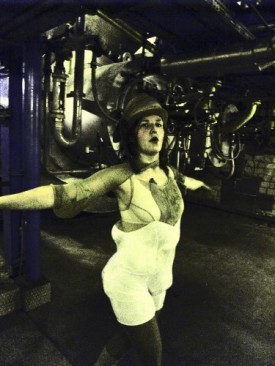 Just in time, performance in EVO,
Just in time, performance in EVO,
Frankfurt am Main (2010)This relationship must be truly intense, often subjecting the performer to different forms of “torture (as in the work of Brian Ferneyhough) and forcing him to perform musical gymnastics involving a number of simultaneous, complicated tasks (odd chords, uncommon performance techniques, and awkward positions and movements). The goal isn’t virtuosity, it’s a physical experience of sound that requires sacrifice, dedication, and readiness to fully open the body up to sound. The musician must follow the instrument and submit to it, not the other way around.
In verb(a)renne life!, the ensemble (wind and percussion, no strings) is equipped with loudspeakers, a variety of papier (normal sheets, poster board, and sandpaper), twigs, and wire brushes. The score describes the required timbre, what hand gestures to make, which hand is supposed to produce which sound (which isn’t just a practical consideration, but also a meaningful element). It also defines the required distances, arrangements of the lips, and actions performed by the mouth, comprising whispers, blowing, and forty different phonemes and syllables, which, in turn, are combined into sonorous “ligatures”.
Instruments are taken apart, leaving nothing but scrolls, endpins, mouthpieces, and bodies. The same happens in per ._o. On one hand, disassembly is a symbolic fragmentation and rift, while on the other, an attempt to reach the essence through radical reduction. verb(a)renne life! is supposed to “sound like a bonfire” in which “everything is to be burned in order to reach the bone”. By stripping the instruments down to the head joint and piano strings, Szmytka attempts to chop the restrictive conventions off of sound. She invokes Michaelangelo, stating that beauty is in the stone itself, and merely needs to be uncovered. The convention of “beautiful sound” is like a fossil; the point is to revive the organic form contained within.
Tablature
In körperwelten, the strings use octave tuning (the g and d¹ strings are tuned to A, and e² is tuned to a slightly higher a¹). The arrows on the time axis represent movements of the hand and fingers, different ways of touching the fingerboard, and bow pressure. The performer operates on precisely defined locations on the body of the instrument, which is amplified with five contact microphones. For everything to work as intended, the score includes a drawing of the fingerboard, the body, and the bridge.
Jagoda Szmytka’s composition method addresses the issue of musical notation. Sounds are not abstract points in space and time, but a product of how the musician holds his instrument. Gesture plays a decisive role in the music by determining the power of the sound. By no longer thinking in terms of sound parameters, instead emphasizing the role played by physical contact with the instrument and combining sounds with shapes and movement, Szmytka produces music that requires the traditional score to be replaced by tablature.
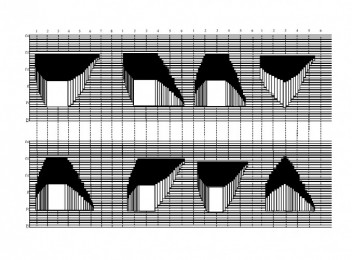 J. Szmytka, study of who when where (2008), score fragment
J. Szmytka, study of who when where (2008), score fragment
In ¿i? study of who where when, the harpsichord/piano score is represented by a series of black shapes meticulously recorded on a grid with time and pitch axes. Resembling graph paper, the grid depicts the registers of the keyboard. The black shapes represent the position of hands and forearms over the keyboard, while the density of the shapes sketches the drama of the piece.
In contrast to traditional cluster notation, black shapes do not denote unified gestures. Szmytka: “I often have to instruct my musicians not to equate their bodies with categories and parameters. When I place my hand on the keyboard, I want it to keep its natural shape. My hand is not a ruler, which is why one key (below the wrist) will be pressed harder than another (under the bend). The shape of the hand leaves an acoustic trace. It’s certainly not going to be a even-sounding cluster.”
The importance of tablature has been diminishing for hundreds of years, replaced by musical notation, for which another alternative — graphic notation — was invented in the 20th century. Tablature as a method of representing chords has survived almost exclusively in popular music and sheet music for amateurs. Jagoda Szmytka’s tablatures therefore provide an excellent point of departure for a discussion on the development of musical scores in Western culture and how it has influenced music itself. The visually intriguing scores that Jagoda Szmytka paints for her own compositions are pieces of visual art in themselves, resembling basso continuo or Braille rather than 20th century graphic notation. They are precise and functional, not just ornamental.
Body
“Sound touches the skin, permeating the tissue, soaking it to the bone; it is direct. Bodies submerged in sound are not just ‘touched’, they become a part of the same space. What more: thanks to sound, they are no longer individual bodies, they are not specific fragments of space, there are no bodily organs or shapes in space: there is no distinctiveness or detachment. There is just the corporeality of the individual sound invigorated by the mutual flow of everything that is.
The flowing energy permeates everything that appears in space and reduces it to a common denominator. Everything comes to life as a colorful magma of movement, rooted in sound. Its pulsating corporeality is neither shapeless nor tangible, yet it constantly increases its own concreteness. What more, the sounds dissolve everything (bodies) from the inside, and directness/indirectness melds into true drifting.”
Tablature notation refers to the body — the way in which the hands operate — rather than to notes as abstract signs on the staff. Tablature determines the location of the body in relation to the instrument: it passes the sound through the body, causing the sound to disappear behind the body.
The gestures, meanwhile, suggest a direct connection between the sound and the body as the intermediary between music and life. The title verb(a)renne life! is a pun consisting of the elements “verbrennen”, to burn, “life”, and “bare”. Szmytka: “The piece explores the gestures/impulses of the human body as a manifestation of life. Every impulse reaffirms itself through never-ending self-enlargement, leading to the development of a unique chain of energy in space: (internal)impulse>body>instrument>air. […] The piece was written as an expression of deep love for life and true love for the loss of memory/history/text/roots-and-all-the-branches-of-the-tree.”
Szmytka’s music is not sonic design, but a laboratory of the body. Körperwelten means “body worlds”; the video uses transformed footage from a real heart exam conducted on the composers. But it is not the image of the beating heart that makes the body real, hyperrealistic, and tangible. Szmytka: “When teaching children to play the violin, we tell them that the bow is an extension of their arm. The instrument augments the body.” It is the instrument that gives the body its shape and makes it complete.
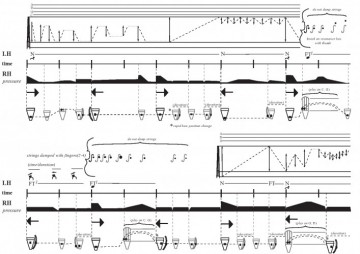 J. Szmytka, körperwelten (2008), score fragment
J. Szmytka, körperwelten (2008), score fragment
Interfering with the instrument by changing its tuning, disassembling it, and even destroying it, is therefore a kind of symbolic interference with the body (cutting, dismemberment, mutilation) that resemble the anatomic experiments of the Renaissance. The illustration to just in time is an old engraving depicting a cross-section of a pregnant woman, where the baby has been replaced with a speaker. But operations also appear in her work in a quite literal sense: in Watch out of the box! (2011) for violin, piano, and prepared speaker, Szmytka slices the speakers open with a scalpel, ripping off parts of the membrane and taping it back up with bandages.
In contrast to many body art projects, Szmytka’s pieces do not produce sound with the body: it is the sound that is the body. Sound has a physical nature; it is like a living organism that is capable of experiencing pain and is subjected to procedures and operations. But as an organ, the sound itself hurts (the composer, the performer, and the audience).
Körperwelten requires the performer to physically experience the instrument, just as the composer experienced her own body in the video recording of her heart. The odd chords cause tension, making them uncomfortable to play. The audio material in just in time (2010) consists of vocal recordings performed in extreme and unnatural positions. Reading concise definitions of bodily organs, the actors suffer discomfort that distorts their voice and affects their interpretation. The installation itself imitates guts that make sound and speak. The space in which it is experienced is a cramped, mobile chamber resembling an intestine. The audience goes inside, where the temperature is close to that of the human body.
In the yet incomplete opera titled Wund-Mensch (Wound-Man), we read the following description: “The protagonist is Wund-Mensch, Wound-Man, a character taken from Renaissance anatomy textbooks. He is at once the writer, who sacrifices his body to the sharp edges of words in order to write, bleeding the text and bleeding to death, and he is the listener, split open by the sound; open to space and open all the way through. For the writer, every act of writing is a kind of death for life, a half-suicide, half-death. And yet that half-death is necessary in order to create the space (scores, performances, and opera stages) for that which was killed to be reanimated. The body blooms and blood begins to flow in the wound inflicted by the sound. In the wound inflicted by the word, it becomes still and acquires meaning.
[…] Yet the cut appears necessary in order to isolate the body itself, in order to pass from homogeneity, amorphousness, a cloud of sensation and emotion, into the body as a contour, a body that is defined and recognizable.”
Form
The above is no more than an outline of the work of Jagoda Szmytka, an artist that eludes words, seeks sounds, gestures, and any forms or expression and thought that our culture and aesthetic sensibilities do not sanction. Her pieces nevertheless constitute a coherent body of interests and themes. Observing her growth in terms of artistic technique shows us that the search for a personal logic, one that explains the ties between objects, is a total process which strives for increasingly precise ways of expressing them in artistic form. A form that will one day come as a challenge.







